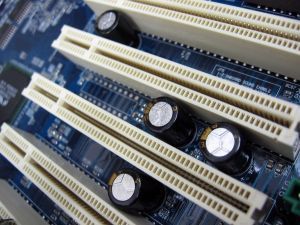PCI Express
PCI Express (Peripheral Component Interconnect Express/PCI-E) is a new computer format for motherboards that allows expansion. It was introduced to phase out PCI expansion and the AGP graphics interface card. PCI Express makes a computer much faster, significantly improves the machine’s graphics performance, and does error checking. It also allows a computer to connect to peripheral devices such as hard drives, cd players, cameras, keyboards, printers, mouses, monitors, USB devices, etc.
Traditional PCI has several limitations. It has a fixed width of 32 bps and can handle only five devices at a time. Peripheral devices share a common pathway to the computer itself, causing the slowest device’s data transfer rate to limit all peripheral devices. A higher bus speed causes the device to experience problems.
These devices became faster and more powerful in the 1990s. The bus graphics evolved from PCI to AGP. The first of this kind were the AGP2X and AGP4X. Today’s AGP8X operates at approximately 2 Gbps. However, the demands for AGP bus development are still putting tremendous pressure on the motherboard.
PCI Express operates like a network and not a bus (see below). It uses a switch to control several point-to-point serial connections that lead directly to the devices where the data needs to go. Since each device has its own dedicated connection, there is no longer a need to share bandwidth like the traditional PCI.
PCI Express comes in different standards: x, 2x, 4x, 8x, 16x, and 32x. Each of these offers much greater bandwidth than the traditional version.
PCI Express is a serial bus standard. This means that information can be transmitted in opposite directions simultaneously. This feature is enabled because the 1x lane in PCI Express can send data in both directions at the same time.
The table below shows the bandwidths offered, including both single and combined directions:
| Common PCI Express buses | Maximum bandwidth | Maximum bandwidth in combined direction |
| PCI Express 1x | 250 Mbps | 500 Mbps |
| PCI Express 2x | 500 Mbps | 1000 Mbps |
| PCI Express 4x | 1000 Mbps | 2000 Mbps |
| PCI Express 8x | 2000 Mbps | 4000 Mbps |
| PCI Express 16x | 4000 Mbps | 8000 Mbps |
| PCI Express 32x | 8000 Mbps | 16000 Mbps |
PCI bus
The PCI bus is an Intel developed local bus standard commonly used for Input/Output (I/O) connections. It connects sound, video, and network cards to the motherboard. Its average speed is about 33 MHz and it yields a throughput rate of 133 Mbps.
Advantages of PCI Express
- PCI Express allows much higher speeds than the traditional PCI. It allows a computer to have a direct connection to each peripheral device that is connected to it, rather than connecting to all devices simultaneously through a shared pathway. This increases the speed at which the computer can communicate with each device and removes the need to access unnecessary hardware in order to communicate with a specific device.
- PCI Express allows less congestion since its bandwidth is not shared in the same way as traditional PCI.
- Increased bandwidth means increased system performance. Since data can get into the system much faster and easier, information can also be obtained as quickly as possible.
- PCI Express is also made with newer technology that allows it to be much smaller than older PCI standards, increasing the number of peripheral devices that can be connected to a single computer.
- PCI Express can be found in both internal and external models, allowing users to manually connect priority peripheral devices to a computer in order to take advantage of the improved performance for those specific devices.


Comments - One Response to “PCI Express”
Sorry but comments are closed at this time.